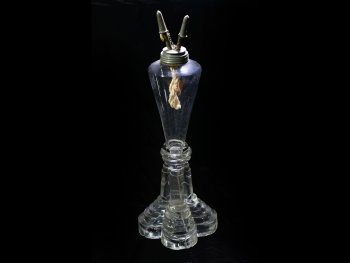Oil / Burning Fluid Lamp
This lamp was created to burn whale oil but was later fitted with a new burner to accommodate burning fluid, a cheaper, and more dangerous, alternative fuel. The new burner’s wicks extended upward at an angle away from the lamp to transfer the heat away from the fuel reservoir to reduce the risk of explosion.
Before the Civil War, whale oil was the gold standard when it came to lamp fuel. This oil, harvested from the head cavities of sperm whales, burned steadily, brightly, and cleanly. It was also increasingly expensive, as overhunting depleted the sperm whale population, and whalers had to travel to the Pacific Ocean to hunt.
Burning fluid is a mixture of turpentine and alcohol, which was developed in the 1830s as a cheaper alternative to whale oil. Although it also burned brightly and cleanly, burning fluid was extremely volatile and was known to explode when not handled properly.
Between 1850 and 1859, 421 people were killed and another 623 were injured by burning fluid lamps. In 1860, the Springfield Illinois State Journal told its readers “burning fluid is a bad thing to have in a dwelling house; it is as dangerous as gunpowder. Don’t burn it--throw your fluid lamps away, and use something that will not explode.”





